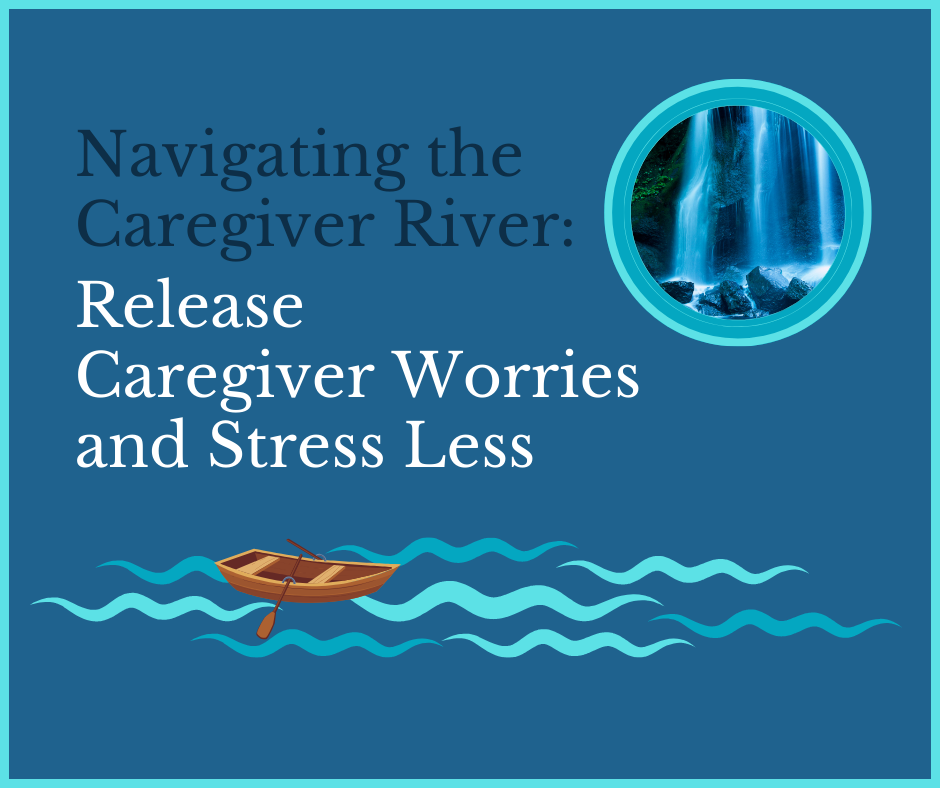A sign of caregiver stress is not being able to escape the worries. Worries flow through our caregiver river, creating unexpected waterfalls and intense rapids that sweep us away. Caregiving worries keep us up at night, disrupt our day, and wreak havoc with our well-being. The 12th Sustainable Caregiving Strategy that supports caregiver self-care is Planning for the Worries. What if we have planned and prepared for all possible events but still can’t escape the waterfall of worries? We continue to catastrophize. When we take a break, we can’t get respite from ruminating. While our concerns are valid, they can govern our lives when we can’t get a break from them.
We can break the worry cycle when we cultivate resilience, employ self-care strategies, and explore our patterns through reflection and journaling to uncover the fears that fuel the worries.
Cultivate Resilience to Manage Worries
Resilience is often associated with coping following an unexpected and challenging event, but it can also be a valuable tool for managing anxiety about potential future events. Building resilience involves developing emotional strength and coping skills. The resilience we cultivate helps us cope with the fear of the unknown by preparing us emotionally to navigate the caregiver river and conquer the waterfall of worries. In addition, these coping skills can help us better manage anxiety about potential negative events by teaching us how to regulate our emotions and respond in a way that doesn’t negatively impact our well-being.
When we cultivate resilience, we learn to adapt our thinking patterns. Adaptation can include reframing negative thoughts and focusing on what we can control rather than fixating on worst-case scenarios. Meditation practice can help us develop adaptive thinking and mental flexibility that allows us to remain resilient. Resilience begets resilience. While resilience may not eliminate all anxiety about the unexpected, it can help us manage it more effectively. Resilience equips us with the tools and mindset to face uncertainty with greater confidence and adaptability, ultimately reducing the paralyzing fear of what might happen.
Resilience following a crisis includes resourcefulness and problem-solving. We can be proactively resilient and establish plans. Planning allows us to set the worry aside with the knowledge that we are prepared to manage the next incident that sweeps us off our feet. Beyond the 12th Sustainable Caregiving Strategy of planning, we can incorporate additional Sustainable Caregiving Strategies. When we employ Sustainable Caregiving Strategies and find the formula that works for us, we cultivate resilience and the skills to reduce stress.
Practice Sustainable Caregiving Strategies to Reduce Worries
How each of us deals with stress during caregiving varies. A one-size-fits-all approach to managing and releasing stress will not work. Trial and error helps lead to the combination of Sustainable Caregiving Strategies that fit you, fit together, and fit your circumstances, which can change daily, sometimes hourly. Each of the Sustainable Caregiving Strategies is self-care. They involve a learning curve, practice, and patience to experience the benefits. When we are burned out, even the activities that support well-being can feel exhausting until we recover. Small steps. persistence and consistency are the path to recovery from burnout. Here are a few of the strategies that can help us release our worries and reduce stress.
Set a boundary around the worry:
We can limit the time we allow ourselves to focus on a worry. When the fear surfaces, we can use a mantra or word to replace the worrisome thought. Setting time aside to worry is also a way to protect ourselves from intrusive thoughts when we gently ask the worry to return at the scheduled time.
Cultivate mindfulness to stay in the present moment:
Meditation and mindfulness techniques can help us stay grounded in the present moment and reduce anxiety about future uncertainties. A regular practice will provide results beyond our mediation or stillness session.
Journal to plan and process the worry:
We can keep a worry journal. When concerns arise, we can write them down along with any possible solutions or steps we can take if the worry becomes a reality. We can explore the worry and discover the fear lurking below the surface. When the fear is exposed, its power is reduced.
Let go of expectations and accept outcomes:
When we accept that we have done our best and cannot control other people’s behaviors, we can let go of expectations and outcomes. Something may happen that we did not foresee, but we can be confident that we have the skills to manage any situation that arises.
Understand when losing is winning:
Reframing by recognizing when losing is winning and transforming our obstacles into advantages helps us focus on the gift hidden within each challenge. We can find ways to improve our situation, grow from the experience, build resilience, and help others facing similar struggles.
Reimagine self-care:
Engaging in self-care activities can reduce overall anxiety and make us feel more capable of handling whatever the future may bring. Self-care practices that promote physical and mental well-being can help us keep challenges in perspective. What gives your life meaning? How can you bring more of those experiences into your caregiving day?
Vent to release the pressure:
Connecting with others who share similar concerns can be helpful. Joining a caregiver support group can help alleviate some of the worries and allow for feedback and support from others who get it. Building a support network can help us share concerns about potential adverse events, receive guidance, and gain perspective. Knowing we have a team of people to lean on can reduce anxiety. If caregiver worries significantly impact daily life and well-being, it may be helpful to seek the guidance of a therapist or counselor specializing in anxiety. Consider Cognitive Behavioral Therapy (CBT). CBT techniques can help individuals challenge and reframe anxious thoughts.
Reconnect with compassion:
It is possible that something was missed. We are under a great deal of pressure. Forgive yourself now for any future misstep, misunderstanding, or missed warning sign. You are doing your best and deserve space and grace to make mistakes. Self-compassion is self-care.
Reflect and Journal to Process and Release Worries
Reflective questions and journal prompts can be effective tools to help us stop ruminating and worrying about unanticipated future challenges. Consider these questions and journal prompts that are designed to encourage introspection and a shift in focus:
Reflective Questions:
- What is the source of my worry about future challenges? Understanding the root cause of our worries can help us address them more effectively.
- Have I faced unexpected challenges in the past? How did I handle them? Reflecting on past experiences of resilience can boost confidence in our ability to meet the unknown.
- What aspects of this situation can I control, and what is beyond my control? Distinguishing between what we can influence and what we can’t can reduce anxiety.
- What are the best and worst outcomes I’m imagining? Identifying extreme scenarios can help bring perspective and highlight more realistic possibilities.
- What steps can I take today to prepare for potential challenges without excessive worry? Encourage proactive thinking and planning without dwelling on the negative.
Journal Prompts:
- Gratitude Journaling: Write down three things you’re grateful for today. Focusing on the positive aspects of your life can shift your mindset away from worrying.
- Future Preparedness: Describe one thing you can do today to prepare for future challenges. Write down actionable steps to address potential concerns.
- Worry Time: Dedicate a specific time each day to worry. During this time, jot down your worries and potential solutions. Setting boundaries around worries can help contain and manage anxiety.
- Positive Visualization: Write a detailed description of a positive and successful outcome for a future challenge you’re worried about. Visualize this scenario to counterbalance negative thoughts.
- Self-Compassion: Reflect on how you typically treat yourself when you’re worried. Write a self-compassionate message to yourself as if you were comforting a friend in a similar situation.
- Mindfulness Journaling: Describe your current surroundings and sensations in detail. Engage your senses to bring your focus to the present moment.
- Letting Go: Write down a worry that you’re ready to let go of. Acknowledge its presence, then symbolically release it by tearing up or burning the paper.
- Progress Journal: Keep a record of your accomplishments and small victories. Celebrate your achievements, no matter how minor they may seem.
Consistent journaling and self-reflection can be a powerful way to break the cycle of rumination and shift toward a more positive and proactive mindset. Use these questions and prompts regularly. Reflection, journaling, cultivating resilience, and employing strategies to help you stay present and empowered will calm the storms and lead to less stress.
For more information on how Sustainable Caregiving Strategies can help you stress and worry less, check out Navigating the Caregiver River: A Journey to Sustainable Caregiving and the Self-Caregiving Strategies Podcast.
Schedule Theresa Wilbanks to speak on caregiving and empower the caregivers in your workplace or community with the 12 Sustainable Caregiving Strategies.
Advice offered is for general information only; please contact your healthcare team, legal or financial advisors to guide your particular situation.

